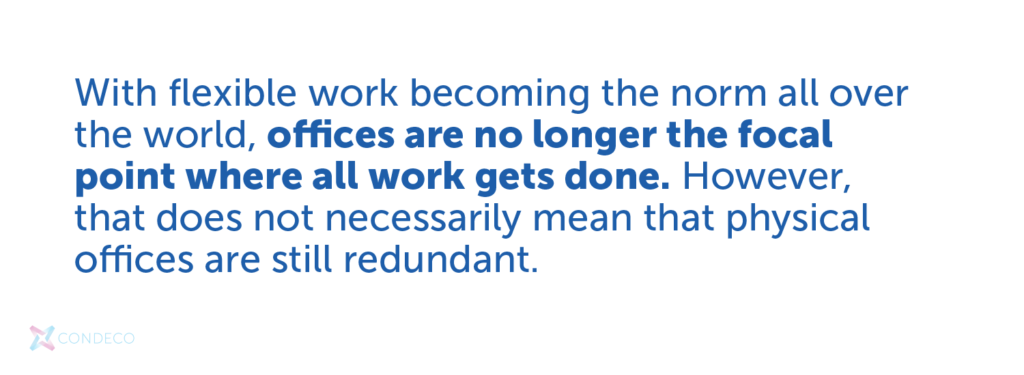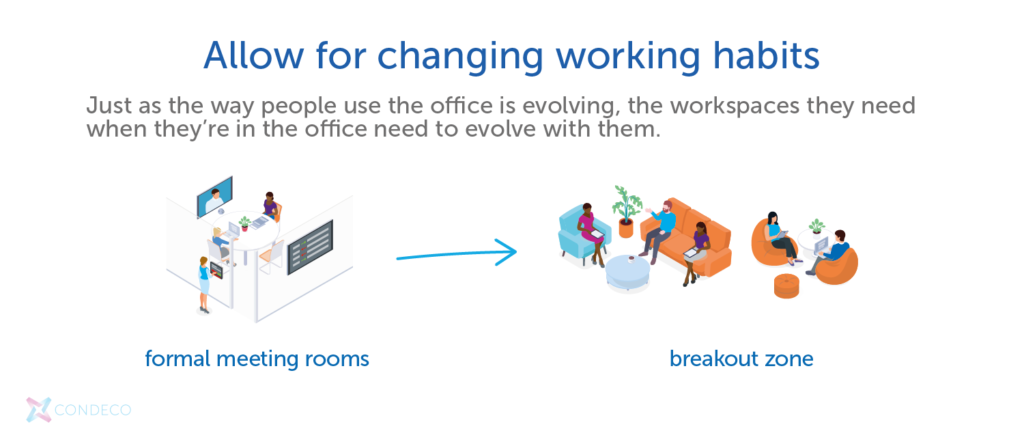
There are lots of reasons why now is the time to consider how your office space management is used, and how changes can be made to make it more efficient, more cost-effective, and serve the needs of your employees better.
Where the highest priorities lie will vary from one business to another, but in the current business landscape, the following issues are commonplace:
- Flexible work: more employees working remotely more of the time has reduced the office headcount day-to-day
- Leasing costs: unnecessary office space generates unnecessary business costs, especially in major cities where rental costs are particularly high
- Climate change: large offices come with a significant environmental burden due to lighting, computer power and temperature control, which businesses bear a responsibility to reduce wherever possible
- Customer trends: more clients and customers may want to conduct meetings virtually rather than at the office in person
Questions to ask yourself about your office space
- Which rooms are most popular? Private offices? Conference rooms? Why do you think they are more popular?
- What equipment is in those popular rooms? Do other spaces need similar equipment?
- Are any rooms or spaces not used enough? Could you do without these or transform them?
- Are ad-hoc or planned meetings more common? How could you account for these?
- How many people use the same desk every day? Would you benefit from more or fewer desks?
There is no definitive answer to these questions; the answers and the outcome you take will be unique to you and your business. Once you have these answers, you can start to tweak your office space management accordingly.
But what does all this mean in practice? This blog explores several areas of consideration that can help organizations address the most common challenges faced by businesses.
How to maximize your office space for productivity
Redefine the workplace
To start with, it may prove helpful to go back to basics and decide exactly what the office exists for, and which specific purposes it can fulfil. Increasingly, with flexible work becoming the norm all over the world, offices are no longer the focal point where all work gets done. However, that does not necessarily mean that physical offices are redundant.

Businesses can explore several avenues to repurpose the office and give employees reasons to travel in when needed. For example, training sessions can be delivered much more easily and effectively in person, while social events that help build a positive company culture similarly need face-to-face interaction. Additionally, the office could be rebranded as a place where employees can get the time and space they need to focus, especially if their home environment isn’t conducive to regular remote working.
Allow for changing working habits
Just as the way people use the office is evolving, the workspaces they need when they’re in the office need to evolve with them. For example, if a group of employees are coming into the building for an informal and creative discussion about a new project, they won’t feel relaxed enough to contribute fully if they’re all sat around a table in a formal meeting room.

What would suit them much better is a breakout zone with more comfortable seating and surroundings that strip away the formality from the discussion. Businesses should therefore look for efficiencies within their real estate and eliminate workspaces that are now surplus to requirements: in particular, a large number of desk spaces can be removed if a business moves towards a model of shared bookable workstations. This extra space can then be redeployed with different types of workspace that better suit employee and business needs.
Allow for flexible work
Allow people to work where they are most productive – whether it’s at home or hot-desking. This will help with office space and bring with it a whole host of other benefits.
Analyzing and reshaping
The important thing to bear in mind about both of the above considerations is that they are not ‘once and done’ activities. The business world doesn’t stand still (especially at the moment) and in an era of rising employee expectations and new ways of working, it’s impossible to know what the future holds for organizations from a flexible work perspective.
That’s why companies should regularly review workspace usage, and the success of their workspace layout, and make changes whenever necessary. These decisions should be driven by data, and the analytics tools within workspace management solutions can take the data from space bookings over time, and uncover insights on where workspace demand exceeds supply (or vice versa).
For example, if a company finds that work pods that employees use for peace and quiet are constantly booked up, the analytics tooling can flag up the high usage rate, so that extra pods can be installed. This helps a business constantly fine-tune its office space to suit the ongoing needs of the workforce, and ensure that the office remains an important and relevant part of their working life.



